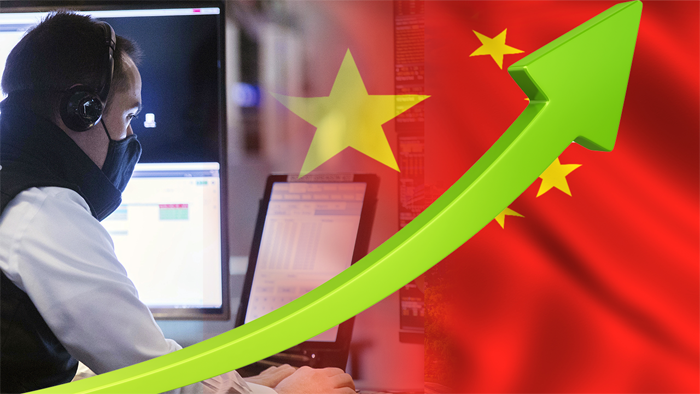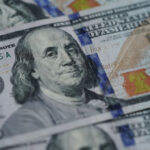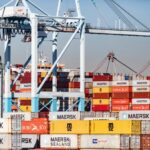By The Wall Street Journal
Trade increases during COVID-19.
China has retaken its mantle as America’s largest trading partner, emerging as a rare bright spot for U.S. farmers and other exporters as the coronavirus pandemic constrains global commerce.
Trade between the two nations rose to $39.7 billion in April, up nearly 43% from the month before, and enough to once again surpass Mexico and Canada. The jump followed the signing of a trade pact in January in which China agreed to sharply step up purchases of U.S. farm products and other goods.
U.S.-China trade remains well below the record $61.4 billion set in October 2018, and economic fallout of the coronavirus pandemic has cast doubt on China’s ability to meet ambitious purchase targets set in the trade accord. China is nonetheless the only major world economy likely to post positive growth this year, according to a recent World Bank forecast.
“China looks like it could be the biggest engine of global GDP growth in 2020 and maybe 2021,” said Craig Allen, the president of the U.S.-China Business Council. “We want American companies to benefit from that absolutely.”
CHINA WILL HONOR TRADE DEAL, WANTS BETTER US TIES
Despite the rise, China is so far not on pace to meet purchase terms under the trade pact, which specifies that it increase purchases of U.S. goods and services by $200 billion over 2017 levels over a two-year period.
Mr. Allen contends that the deal shouldn’t be judged solely on the purchase targets, however, pointing out that China’s commitment to scaling back regulatory measures is of greater long-term significance to U.S. companies.
TRUMP TOUTS ‘FANTASTIC’ ECONOMIC REBOUND, RETHINKS CHINA RELATIONSHIP AFTER CORONAVIRUS
“There have been very significant regulatory changes in intellectual-property rights, agriculture and financial services,” said Mr. Allen.
It is yet to be seen how far China will go in enforcing intellectual-property rights of foreign companies—long a sore spot with U.S. companies that say Chinese competitors have appropriated their trade secrets with impunity. But by at least one metric—for agricultural products—China has stepped up its purchases.
U.S. farmers felt the brunt of the trade war, as China retaliated against U.S. tariffs by scaling back purchases of soybeans, corn and other farm exports.
In recent months, however, China has boosted its purchases of crops like corn, wheat and soybeans to higher levels than before the trade war. And China has emerged as a more pivotal buyer than ever—in the five weeks through June 4, for example, China purchased about two-thirds of all gross sales of U.S. soybeans.
ZOOM RESPONDS FOLLOWING CHINA CONTROVERSY
To be sure, even with the economic benefits of the refreshed relationship with China, the massive shortfall in the Chinese purchase targets could present a growing quandary for the Trump administration if the aggressive two-year purchase targets aren’t met.
And beyond trade, other tensions are festering between the two nations, including China’s moves to dismantle Hong Kong’s autonomy and the U.S. criticism over China’s handling of the initial outbreak of Covid-19, the disease caused by coronavirus.
“Covid has made China politically toxic,” said Derek Scissors, a resident scholar at the American Enterprise Institute, a conservative think tank. “Even if U.S. exports somehow move much higher, much faster than anyone expects, it can no longer give the president what he was looking for politically. There’s no way for him to claim Phase 1 [of the planned multiphase deal] has made the China relationship a success.”
Already, political clamor has been growing around whether China would reach the targets. Sen. Rick Scott (R., Fla.) sent a letter June 11 to the Office of the U.S. Trade Representative saying “we must focus on holding China accountable if they fail to comply” with the purchase goals.
TWITTER REMOVES CHINA-LINKED ACCOUNTS SPREADING FALSE INFORMATION
Publicly, despite the pressure and shortfalls, Chinese and U.S. officials have signaled they are attempting to see the deal through. In May, the USTR issued a rare statement, saying that Chinese and U.S. officials “agreed that in spite of the current global health emergency, both countries fully expect to meet their obligations under the agreement in a timely manner.”
A companion statement from Chinese said both sides were working to create favorable conditions for the trade deal.
U.S. Trade Representative Robert Lighthizer is expected to face questions over the deal at appearances before House and Senate committees Wednesday.
Even with a strong global economy, the countries would have needed an unprecedentedly rapid increase in trade of many items to hit the goals.
1,300 CHINESE MEDICAL SUPPLIERS TO US USE BOGUS REGISTRATION DATA
“I have been skeptical that the targets would be achievable—for economic reasons—even before” the pandemic damaged the Chinese and global economy, said Chad Bown, a senior fellow at the Peterson Institute for International Economics.
Mr. Bown calculates that China needs to purchase $172 billion of U.S. goods this year to meet the target for 2020. With data now tallied for the first third of the year, China should have purchased about $58 billion of goods to be on track to hit the goal.
So far, however, China has purchased just $26 billion of goods, less than half the pace it needs to meet its goal for 2020, according to Mr. Bown’s calculations.
The deal specified an even more aggressive target for 2021, and more favorable economic conditions could give China a better chance at hitting the target in the second year.
China is about halfway to its target on agriculture for 2020, but is already buying over half of some U.S. crop exports. There is no way for a country buying more than 60% of an exported commodity to double its share of purchases of those items.
For other goods, the plunge in financial markets is a profound challenge. China is on pace for only about 3% of the U.S. energy purchases to which it was committed. The collapse of global energy prices in 2020 has placed this goal even further out of reach, at the same time as the slowdown in economic demand means even China doesn’t need as much energy as expected this year.
When the trade deal was signed in January, a barrel of oil traded for about $65. In April, oil prices dropped below $20 a barrel (with some contracts even turning negative). That presents an enormous challenge for targets that were agreed to in terms of total dollars. At $20 a barrel, China would have to buy more than three times the volume of oil to hit the same target as when oil was $65.
Finally, China also agreed to boost trade in services, a goal that could prove impossible to hit now amid the travel restrictions that have been imposed to thwart the virus. Over half of U.S. service exports to China take place via tourism and higher education, so restrictions directly stop such activities from occurring.
At the same time, the deal’s regulatory provisions paved the way for U.S. banks, credit-card networks, insurance companies and investors to do business in China, presenting one of the best growth opportunities for U.S. financial services in years, and another example of a win for businesses even as the services target is missed.
“If anything, the pandemic provides the Trump administration an excuse to keep the deal going despite China’s lack of progress toward meeting the unreasonable purchase targets,” said Mr. Bown.





![US Stocks Tumble After Trump Reveals Tougher-Than-Expected Global Tariffs | USNN World News U.S. stocks saw a sharp decline on April 3 after President Donald Trump imposed steep tariffs on many nations during a White House Rose Garden address on April 2, marking a new era in U.S. trade policy. In the weeks leading up to the tariff announcement, markets had already faced significant volatility, with some believing the actual risk was overstated. However, Trump’s decision to implement his plan caught many off guard, with the tariff rates proving to be more aggressive than anticipated. Trump sought to downplay the market’s reaction, saying that the financial markets will take off once the new levies are in effect. Story continues below advertisement Briefly speaking to reporters before heading to Florida to participate in a golf event, Trump stated that as much as $7 trillion would enter the United States, resulting from investments coming into the country. “The markets are going to boom,” he said, adding that “the country is going to boom.” The president said other countries “have taken advantage of us for many, many years.” Related Stories Here’s How Much the US Is Tariffing Each Country 4/3/2025 Here’s How Much the US Is Tariffing Each Country Dow Jones Drops 1,100 Points a Day After Trump Tariff Announcement 4/3/2025 Dow Jones Drops 1,100 Points a Day After Trump Tariff Announcement The Dow Jones Industrial Average, an index of blue-chip stocks, crashed by more than 1,600 points on April 3. The tech-heavy Nasdaq Composite Index tanked by nearly 6 percent, and the broader S&P 500 fell by 4.8 percent. “Yesterday’s Liberation Day festivities in the Rose Garden set off a freefall in stock prices on increasing fears of a trade war,” Ed Yardeni, an economist and the president of Yardeni Research, said in a note. “The worst-case scenario is a recession if high tariff rates stick, leading to a slowdown in business and consumer spending that causes layoffs.” Yardeni increased the odds of a recession or stagflation event to 45 percent from 35 percent on March 31. The Russell 2000, a benchmark average for about 2,000 small-cap stocks, cratered 6.5 percent. It became the first U.S. stock index to slip into a bear market, down by more than 20 percent from its all-time high close on Nov. 25. Small-cap stocks usually have market caps between $300 million and $2 billion and are more volatile amid worsening economic conditions. With growing tariff-driven recession fears, these stocks could be more sensitive to trade policy changes. Sectors See Sharp Losses Aside from consumer staples, all major S&P sector indexes were swimming in an ocean of red ink on April 3. Story continues below advertisement Energy, technology, and consumer discretionary sectors took the hardest hits, with losses of around 7 percent. Industrials and financials fell by about 5 percent. Materials and real estate tumbled by 4 percent and 3 percent, respectively. The health and utilities sectors dipped by about 1 percent. “I am scratching my head as everyone else,” Stoyan Panayotov, founder and CEO of California-based Babylon Wealth Management, told The Epoch Times. “I think the market was very shocked and confused,“ he said. ”The level of tariffs for our trading partners and allies is mind-boggling.” Panayotov noted that the markets reacted negatively to the announcement because, rather than providing clarity, it introduced greater uncertainty about the future. After flirting with $3,200 earlier in the week, gold also joined the wider market selloff. Gold prices tumbled from $38.10, or 1.2 percent, to $3.128 per ounce on the COMEX division of the New York Mercantile Exchange. Still, the yellow metal is up more than 18 percent this year and 36 percent over the last 12 months. The conventional safe-haven asset has immensely benefited from investors seeking shelter amid the market turmoil. Gold prices have also risen on sliding U.S. Treasury yields and a weakening U.S. dollar. Gold is typically sensitive to interest rate fluctuations because it can influence the opportunity cost of holding non-yielding bullion. A lower greenback, meanwhile, is bullish for gold since it makes it cheaper for foreign investors to purchase. But there is one silver lining, as oil prices are coming down. West Texas Intermediate (WTI) crude, the U.S. benchmark for oil prices, declined by nearly 7 percent to below $67 a barrel on the New York Mercantile Exchange. Brent, the international benchmark for oil prices, was also down close to 6 percent, sliding toward $70 a barrel on London’s ICE Futures exchange. Crude plunged after eight important OPEC+ producers—Algeria, Iraq, Kazakhstan, Kuwait, Oman, Russia, Saudi Arabia, and the United Arab Emirates (UAE)—chose to collectively accelerate output by 411,000 barrels per day, effective in May. “The gradual increases may be paused or reversed subject to evolving market conditions. This flexibility will allow the group to continue to support oil market stability,” the Organization of the Petroleum Exporting Countries (OPEC) said in a statement. According to energy market analyst Phil Flynn, once again, markets underestimated Trump and his resolve. However, he noted that Americans will likely benefit from cheaper prices at the gas pump. “President Trump imposed tariffs on various countries but exempted oil, gas, and refined product imports,” he said in a report. “This exemption reflects his commitment to keep energy prices low for Americans.” Some analysts suggest that, for those with a long-term perspective, this may be an ideal time to invest in the market. “If your time horizon is 5, 10, or 20 years, this will be a great buying opportunity,” Panayotov said. While small caps have been underperforming large caps, Charles LaRosa, an investment analyst at Gabelli Funds, thinks there could be an opportunity to own small-cap stocks, particularly in the current climate. “Small-cap stocks are poised to benefit from several key trends,” LaRosa said in a note emailed to The Epoch Times. “Reshoring efforts are bringing manufacturing and supply chains back to [the] U.S., boosting local businesses.” A declining interest rate environment could also bolster small-cap stocks. New Trade Policy Trump has imposed a 10 percent baseline tariff on all imports, effective April 5. Some trading partners will pay this rate only, including the UK, Singapore, Brazil, Australia, New Zealand, Turkey, Colombia, Argentina, El Salvador, UAE, and Saudi Arabia. Nearly 60 countries listed as “worst offenders” will face higher reciprocal tariffs due to their significant trade barriers, including high tariffs on U.S. goods, non-tariff barriers such as currency manipulation, and value-added taxes (VATs). These tariffs will take effect on April 9. The trading partners that made the “worst offenders” list include the European Union (20 percent), China (54 percent), Vietnam (46 percent), Thailand (36 percent), Japan (24 percent), Cambodia (49 percent), South Africa (30 percent), and Taiwan (32 percent). “Our initial estimates of the reciprocal trade order suggest that the overall U.S. tariff rate could rise into the 25-30% range if the new tariff rates are sustained for a significant period of time—the highest levels since the 1930s,” Deutsche Bank analysts wrote in a note. Analysts warned that these new measures could reduce economic growth by 1 to 1.5 percentage points this year, significantly increasing the risk of a recession, while also contributing a similar rise to core PCE inflation. Commerce Secretary Howard Lutnick, in a CNBC interview, said these new tariffs will force other nations to lower their trade barriers against U.S. goods. “This is the reordering of fair trade,” he said on April 3. “It’s about those non-tariff trade barriers. That’s what we are addressing.” “I expect most countries to start to really examine their trade policy towards the United States of America, and stop picking on us,” he added. “Stop saying that we can’t sell our corn to India, stop saying that we can’t sell our beef anywhere. Just stop treating us so poorly.” Global Markets Tank Trump’s new tariff regime also created a tsunami in European and Asian markets. Japan’s Nikkei 225 declined by 990 points, or 2.77 percent. Hong Kong’s Hang Seng Index erased 352 points, or 1.52 percent. The South Korean KOSPI Composite Index slipped by 0.8 percent. Germany’s DAX declined by 673 points, or 3.01 percent. London’s FTSE shed 133 points, or 1.55 percent. The French CAC 40 Index also fell by 260 points, or 3.31 percent. While Canada was absent on the list of baseline and higher reciprocal tariffs, the TSX Composite Index crashed more than 900 points, or about 3.7 percent. According to Jeff Buchbinder, chief equity strategist at LPL Financial, next week could be a real test for the financial markets as the highest tariff rates take effect on April 9. “Stocks should stabilize once negotiations start to bear fruit and take rates down, assuming it’s clear to markets that no meaningful tariff rates will be increased further because of retaliation,” Buchbinder said in a note emailed to The Epoch Times. Following the president’s announcement, Treasury Secretary Scott Bessent appeared on multiple news programs and delivered the same message urging nations not to engage in retaliation. “My advice to every country right now is do not retaliate. Sit back, take it in, let’s see how it goes, because if you retaliate, there will be escalation. If you don’t retaliate, this is the high-water mark,” Bessent said in an interview with Fox News host Bret Baier. Tom Essaye, president and founder of Sevens Research Report, does not believe the tariffs will lead to a “bearish gamechanger.” “This is because administration officials signaled they were open to negotiations and there were various exemptions, including all USMCA-compliant goods, chips from Taiwan, and drugs (pharmaceuticals) from Europe,” he said in a statement emailed to The Epoch Times. “While the tariff announcement wasn’t a worst-case scenario (that would have happened if there was no hope of global tariff reduction), it was an incremental negative and we should expect more market volatility in the near term.” Reactions Mount The U.S. Chamber of Commerce said in a statement that businesses think these broad tariffs are tax hikes that will raise consumer prices and weigh on economic growth prospects. “We urge policymakers to instead focus efforts on accelerating the pro-growth agenda of extending our current tax policy, re-balancing regulations, and unleashing the full potential of American energy—all policies that will grow the economy and create more opportunities for Americans,” said Neil Bradley, chief policy officer at the U.S. Chamber of Commerce. Bradley noted that the White House should consider negotiating new trade deals to bolster access for U.S. businesses that “will support more American jobs and lower prices.” The Business Roundtable agreed with Trump’s efforts to garner better trade agreements that can lower tariffs and expand market access. “However, universal tariffs ranging from 10-50% run the risk of causing major harm to American manufacturers, workers, families and exporters,” Joshua Bolten, CEO of Business Roundtable, said in a statement. “Damage to the U.S. economy will increase the longer the tariffs are in place and may be exacerbated by retaliatory measures.” Story continues below advertisement Kevin Dempsey, president and CEO of the American Iron and Steel Institute, commended Trump’s initiative to restore fairness and address non-tariff trade barriers. “Driven by subsidies and other foreign government trade-distorting practices, global overcapacity in the steel industry reached 573 million metric tons in 2024 and has spurred high levels of exports of steel from countries like China, Japan, Korea, Vietnam and Indonesia that continue to produce steel in volumes that significantly exceed their domestic demand,” Dempsey said in a statement to The Epoch Times.](https://www.usnn.news/wp-content/uploads/2025/04/US-Stocks-Tumble-After-Trump-Reveals-Tougher-Than-Expected-Global-Tariffs-150x150.jpg)
